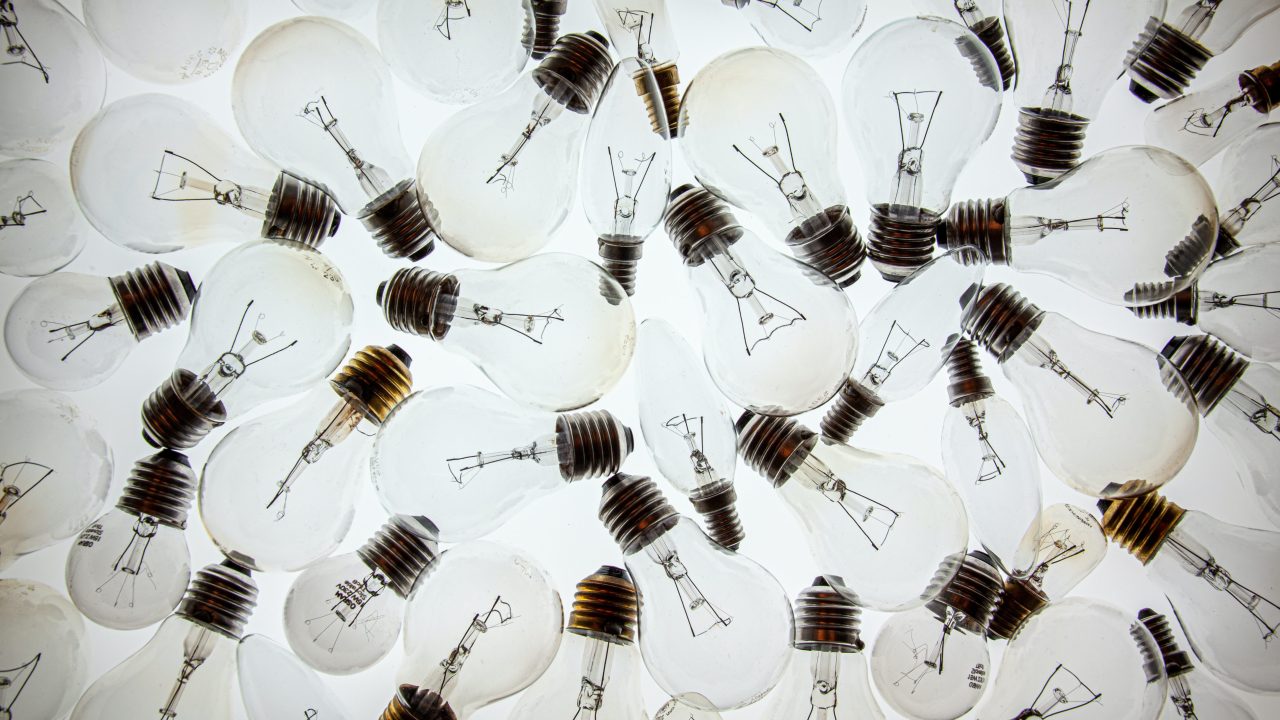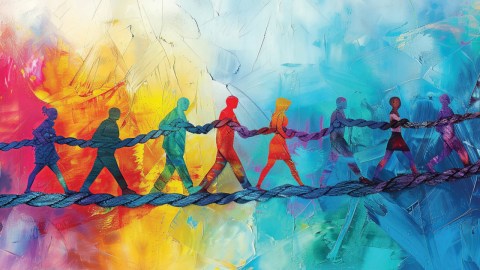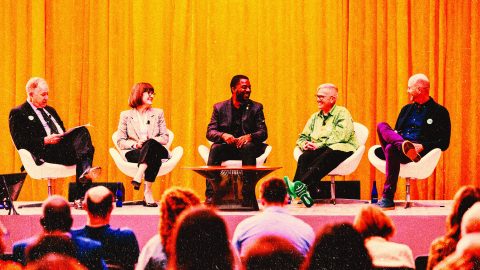
Dispatches from the Center for the Future of Museums is a museum newsletter like none other, offering far-reaching analysis of emerging social, technological, economic, environmental, and political trends and how they might impact our sector. In addition to news stories from across the media landscape capturing important signals of change, it also regularly shares stories of museums conducting novel practices in the field. Only time will tell whether these innovations become widespread, but if they do, you can say you read about them in Dispatches first. If an experimental, forward-looking mindset is on your resolutions list for 2024, get a head start by subscribing today for these weekly bursts of inspiration.
In the meantime, we thought we’d take a look back at some of the new ground museums broke this year. Here is a sampling of the stories shared last year, one from each month of 2023:
January
Louvre will begin significantly limiting daily visitor numbers to create ‘more pleasurable viewing experience’
The Art Newspaper
In 2022, the Louvre received 7.8 million visitors—19% less than in 2019, albeit a rise of 170% from 2021 when French museums were closed for nearly five months. But the fall in attendance is not necessarily bad news. The Louvre director Laurence des Cars has hit the pause button and decided to limit daily entries to 30,000. Prior to Covid-19, the museum could welcome up to 45,000 people on its most crowded days. With 80% of tickets now issued via a reservation service, the new policy should stabilise attendance at between 7.5 million and 8 million visitors for 2023, the same levels experienced by the museum around 17 years ago. In a statement, Des Cars said she opted for the change “so the visit would be a pleasurable experience, especially for first-timers to the museum who make up 60% of entries.”
February
In Controversial Move, British Museums Will Avoid Using ‘Mummy’ to Describe Mummified Remains
ARTnews
The British Museum in London, the National Museums of Scotland and the Great North Museum: Hancock have decided to change when they use the term “mummy” as part of a broader re-examination of how exhibits are described, labeled, and presented to the public. Instead, they will use “mummified remains of” or “mummified person” to describe the Egyptian artifacts whenever possible. The shift in language to describe exhibits of these major Egyptian artifacts also follows an ongoing reexamination of colonialism in the United Kingdom, and the horrific way the mummified remains were treated in the past.
March
Two San Francisco museums launch joint curatorial position focused on art of the African diaspora
The Art Newspaper
The San Francisco Museum of Modern Art (SFMoMA) and its close neighbour, the Museum of the African Diaspora (MoAD), are launching a joint curatorial position to generate exhibitions and programmes bridging the two institutions. With the title Assistant Curator of the Art of the African Diaspora, to rotate every three years, the job is designed to offer more opportunities to Black curators early in their careers and provide substantive experience to help advance them to the ranks of museum leaders. SFMoMA, which has an operating budget of more than $56m in contrast to MoAD’s $5m, will fully fund the salary of the new assistant curator who will work with the curatorial teams at both institutions and steward acquisitions of work by Black artists for SFMoMA (MoAD is non-collecting).
April
Madison Children’s Museum opens pay-what-you-can cafe
The Cap Times
Little John’s Lunchbox, the [Madison Children’s Museum’s] new cafe, is a pay-what-you-can restaurant, seemingly the first in a U.S. museum. The latest project of the nonprofit Little John’s Kitchens, invites the public to choose from half a dozen pre-packed entrées and then decide what to pay: a little, a lot, or nothing at all. Staff and volunteers prepare meals using fresh ingredients donated by grocery stores and farms—food that otherwise might go to waste. The cafe isn’t just for museum visitors. Like the museum’s prior cafe, it’s open to the public during all museum hours, inviting anyone to eat and explore the exhibits in the museum’s front area, called the Community Concourse, without paying admission. In that way, the museum is bringing the pay-what-you-can model to downtown Madison as a whole.
May
‘Not just a problem of science’: how the environmental crisis is also cultural
The Guardian
Nature, Crisis, Consequence [at] the New-York Historical Society juxtaposes classics of 19th-century American naturalism with works by artists from communities largely left out of the historical narratives that these works have been central in enshrining. [The exhibit] contextualiz[es] classic 19th-century Hudson River school paintings by surrounding them with work made by groups who had largely been excluded from the histories told about these times and places. [Curator Dr Wendy Nālani E Ikemoto] hopes that Nature, Crisis, Consequence will push audiences’ understanding further and help them connect the links between history, civil rights and the climate crisis. She believes that, ultimately, filling out these stories is not only correctly serving NYHS’s public, but also offering a better understanding of our nation’s past and present.
June
Juneteenth puts focus on preserving enslavement sites
Axios
Historic sites linked to enslavement and emancipation are getting new attention—and funding for preservation—after years of neglect. Pressure and new funding from public and private entities are beefing up demand to include the voices of enslaved people at sites. The “(Un)Known Project Augmented Reality App” in Louisville, Ky., [will] allow visitors to see images of enslaved people via an app near the Louisville Riverwalk as they looked toward freedom across the river in Indiana. The African American Cultural Heritage Action Fund is developing a mapping project to identify and locate all Black American cultural sites, including those linked to enslavement. It will be created on an app to help visitors locate sites, many of them relatively obscure.
July
Museums in Scotland required to pay Living Wage to apply for public funding
Museums Association
Museums and galleries in Scotland must pay all of their workers at least the real Living Wage to apply for grants, following changes to funding criteria introduced by Museums Galleries Scotland (MGS). The funding and development body is required to align its criteria to the Scottish Government’s Fair Work First policy, which applies to grants and public contracts being awarded by and across the public sector. Fair Work is also a priority area in MGS’s recently launched strategy for 2023-30. MGS has produced a Fair Work Resources for Employers page to help museums find support and guidance towards becoming a Fair Work employer. It encourages museums to seek accreditation from the Living Wage Foundation.
August
New augmented reality app turns objects at the Metropolitan Museum into digital gaming accessories
The Art Newspaper
The Metropolitan Museum of Art announced today that it has partnered with telecommunications company Verizon to launch Replica, a new app that allows users to engage with art from its collections in virtual space. The app can be used with Roblox, the popular gaming platform, where a new virtual version of the Met, including spaces like its Fifth Avenue façade and its Great Hall, can be explored. The new app, available for free on iOS and Android devices, encourages in-person trips, inviting visitors to scan certain objects that can then be transferred to Roblox. Designed for children and young adults, the app aims to present an immersive cultural and educational experience. It also marks the Met’s latest move to lure back visitors after seeing a major drop in attendance since the Covid-19 pandemic.
September
Museum Curators Evaluate A.I. Threat by Giving It the Reins
The New York Times
Curatorial staff at Duke University’s Nasher Museum of Art embraced a challenge posed by their chief curator: [could] A.I. replace them effectively[?] The experiment’s result, the exhibition “Act as if You Are a Curator,” is one of the first examples of A.I. organizing an art exhibition. ChatGPT, a prominent chatbot developed by the company OpenAI, was able to identify themes and develop a checklist of 21 artworks owned by the museum, along with directions of where to place them in the galleries. But the tool lacked the nuanced expertise of its human colleagues, producing a very small show with questionable inclusions, mistitled objects and errant informational texts. The human curators added their own commentary on the labels to point out its quirks and inaccuracies. Despite the errors, some Nasher curators said it was easy to see how A.I. could support [their work].
October
Penn Museum will no longer display exposed human remains
WHYY
Penn Museum has updated its policies regarding the handling of human remains, and decided to no longer put “exposed” remains on exhibition. Wrapped mummies or remains enclosed in a vessel will still be considered for display with signage forewarning visitors. But all visible human tissue — such as bones, teeth, and hair — will be removed from view. Displays may still involve recreations of human remains such as molds cast from the original. The policy extends to Penn Museum’s educational programs, which will use artificial remains for teaching purposes in most circumstances. The museum’s decision to bar display of remains goes further than most other museums. While most major institutions have policies regarding the ethical treatment of remains, few have banned them from view.
November
Barcelona museum throws open its doors to nudist visitors
Reuters
A Barcelona museum opened its doors to nudists on Saturday, holding a special tour during which visitors could ditch their clothes. The Museum of Archaeology of Catalonia held the 90-minute tour in collaboration with the Catalan Naturism Club. Visitors viewed the Bronzes of Riace exhibition of Luigi Spina’s photographs depicting two large Greek bronze statues of naked warriors from the 5th century BC that were discovered in 1972 near Riace, Italy. The museum’s website promised visitors the chance to “admire the works by posing in the same situation as they are, completely naked and surrounded by other bodies”.
December
Bloomberg to use Natural History Museum data for biodiversity tool
Responsible Investor
Launched in 2014, the Natural History Museum of London’s Biodiversity Intactness Index (BII) measures the biodiversity makeup of a specific terrestrial area in comparison to a pristine area with minimal human interference. Ecosystem integrity is categorised on a scale from 100 percent (the naturally present biodiversity remains intact) down to 0. The BII is built on the Natural History Museum’s PREDICTS database, which incorporates peer-reviewed biodiversity data from over 50,000 sites across the globe, spanning more than 100 countries. Now Bloomberg plans to build a tool that combines the museum’s geospatial BII data with its own data on more than one million physical assets linked to nearly 50,000 global companies. This will allow companies to see their proximity to intact ecosystems and the scale of degradation to ecosystems near company operations over time.








